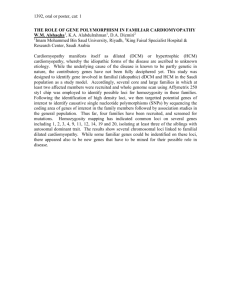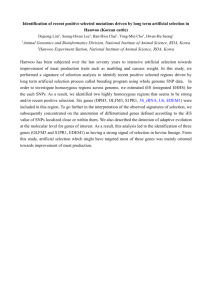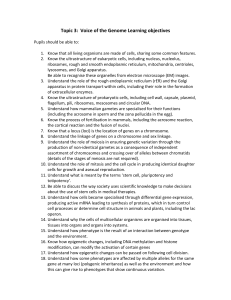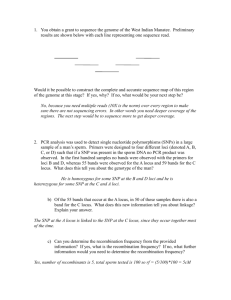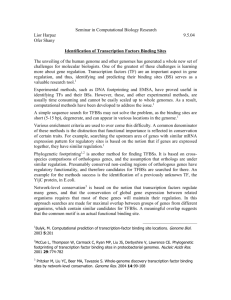downloaded
advertisement
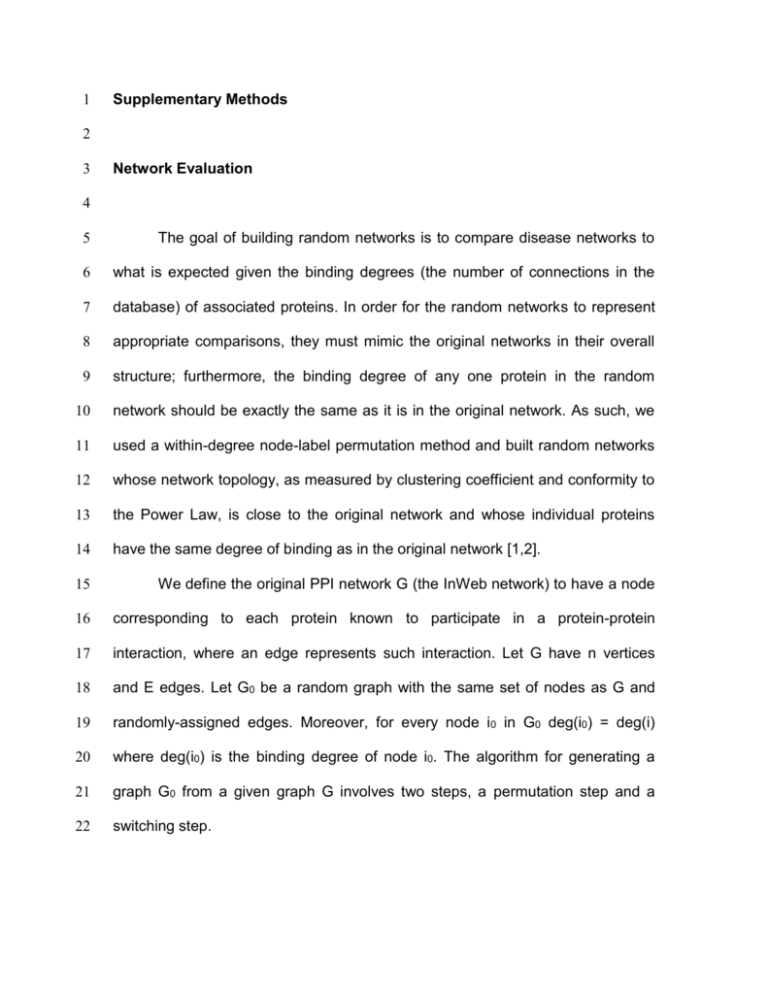
1 Supplementary Methods 2 3 Network Evaluation 4 5 The goal of building random networks is to compare disease networks to 6 what is expected given the binding degrees (the number of connections in the 7 database) of associated proteins. In order for the random networks to represent 8 appropriate comparisons, they must mimic the original networks in their overall 9 structure; furthermore, the binding degree of any one protein in the random 10 network should be exactly the same as it is in the original network. As such, we 11 used a within-degree node-label permutation method and built random networks 12 whose network topology, as measured by clustering coefficient and conformity to 13 the Power Law, is close to the original network and whose individual proteins 14 have the same degree of binding as in the original network [1,2]. 15 We define the original PPI network G (the InWeb network) to have a node 16 corresponding to each protein known to participate in a protein-protein 17 interaction, where an edge represents such interaction. Let G have n vertices 18 and E edges. Let G0 be a random graph with the same set of nodes as G and 19 randomly-assigned edges. Moreover, for every node i0 in G0 deg(i0) = deg(i) 20 where deg(i0) is the binding degree of node i0. The algorithm for generating a 21 graph G0 from a given graph G involves two steps, a permutation step and a 22 switching step. 1 Permutation Step: Let k1, k2, k3, ..., km be the sequence of all possible 2 node degrees in G and let Ki be the set of vertices that have degree ki with 1 ≤ i ≤ 3 m. The following procedure permutes sets of same degree nodes 1,000 times: 4 1. Repeat the following 1,000 times: 5 2. For every set Ki, 1 ≤ i ≤ m 6 (a) Choose randomly two vertices a and b. 7 (b) Swap its positions in set Ki. 8 The permutation step has a high impact in randomizing graph G but it has 9 one limitation: the algorithm cannot perturb nodes that have unique degrees. 10 Scale-free networks have a particular degree distribution that follows a power- 11 law, at least asymptotically [2]. The fraction P(k) of nodes in the network having k 12 connections to other nodes goes for large values of k as P(k) ~ k-γ where γ is a 13 constant whose value depends on the network. The presence of high degree 14 nodes in the network, often referred to as “hubs”, that have unique degrees 15 creates several situations where our method cannot permute. 16 Let Gunique be the union of sub-networks consisting of high-degree nodes 17 and their edges. In order to completely randomize graph G we apply an edge 18 permutation algorithm for network Gunique. 19 Switching Step: The edge permutation algorithm starts from a given 20 network and involves carrying out a series of switching steps whereby a pair of 21 edges (A−B, C−D) is selected at random and the ends are exchanged to give 22 (A−D , B−C) or (A−C , B−D). The exchange is only performed if it generates no 23 multiple edges or self-edges; otherwise, it is not performed. The entire process is 1 repeated some number T2E times, where E is the number of edges in the graph 2 and T2 is the switching threshold, chosen large enough that the mixing is 3 sufficient. The switching algorithm is used as a second step in our method, 4 continuing the randomization process of graph G after the permutation step. It is 5 applied only to Gunique graph defined by the set of nodes with unique degrees and 6 their edges. The following procedure perturbs Gunique. 7 1. Repeat the following T2 times: 8 2. While there are nodes unvisited 9 10 (a) Choose randomly edges A−B and C−D (b) If A−D and B−C do not exist 11 i. Add edges A−D and B−C to G0 12 ii. Remove edges A−B and C−D from G0 13 14 The benefit of the permutation method used is that we repeat the 15 entire process to generate 50,000 permuted networks perfectly matched for size, 16 binding degree of proteins within it and overall network structure. As we show in 17 the candidate gene section, this method importantly allows us to score individual 18 proteins in the network, in addition to the network as a whole. Note that since we 19 remove within-locus binding from the original network, random networks then 20 have to be disease-specific. The files placed on our online resource are not 21 disease specific in order to be universal – however, removing within-locus 22 binding before generation of random networks compared to removing them 23 afterward results in minor differences. 1 2 To ensure the robustness of our significance, we tested two alternative 3 methods: we (1) built networks from randomly selected SNPs and (2) permuted 4 all the edges, rather than only networks of nodes with unique degrees. We 5 carried this out in CD and RA. Permuting the SNPs requires that the randomly 6 chosen loci be matched for gene content as well as average binding degree of 7 encoded proteins; method 1 is thus severely limited by the strict matching 8 criteria, making this method unsuitable, and additionally, it does not easily allow 9 for scoring of individual proteins. Thus, we permuted 1000 times and remove 10 permutations for which the binding degree distribution of proteins in randomly 11 selected loci was different (binding degree was greater or less than the mean of 12 the disease proteins’ binding degrees plus or minus 10, respectively, and the 13 protein with the highest binding degree was more than the disease protein with 14 the highest binding degree plus 20). Method 2 involves randomly shuffling the 15 edges such that the number of edges per protein is preserved but the identity of 16 binding partners is changed. Overall, the significance is replicated, though the 17 SNP matching was to a lesser extent (since we were unable to match for full 18 binding degree in most cases). The results of the aforesaid two methods are 19 shown in Figures S3 and S4. 20 21 22 Evaluation of Permutation Method 1 To test whether our permutation method created random networks that 2 matched the InWeb network in overall properties, we computed the binding 3 degree distribution and the clustering coefficient for each random network. The 4 binding degree distribution of the InWeb network, which is scale-free, follows the 5 power law, and the random networks should too if they are structured like the 6 InWeb network [2-4]. Because we permute within-degree, the distribution should 7 be identical; indeed, we found that the random networks follow the power law 8 and their distribution, which fits k-1.7 (where k is equal to a given binding degree), 9 are equivalent to the InWeb network. Secondly, the clustering coefficient, C, 10 which is the probability that two binding partners of a vertex are connected, was 11 computed for the random networks and the InWeb network. We found that the 12 InWeb clustering coeffecient was close to that of the random networks: C for the 13 InWeb network was 0.261 and the mean C for the random networks was 0.197. 14 The difference is due to the small amount of edge permutation that we perform 15 on nodes with unique degrees. 16 Next, we tested the distribution of p-values that the permutation method 17 reported for randomly selected groups of 30 SNPs (to roughly mimic RA and CD 18 loci sets). If the permutation method correctly tested the null hypothesis, then the 19 distribution of p-values for each metric should be uniform. For 50 such random 20 groups of SNPs, we find via a 2 test for uniform distribution that the network 21 connectivity, the common interactor connectivity, and the associated protein 22 indirect connectivity fit what is expected under a uniform distribution (p = 0.923, p 23 = 0.787 and p = 0.896). The associated protein direct connectivity is skewed 1 towards insignificant p-values (p = 1), and thus the p-value distribution for this 2 metric is less uniform. However, the skew towards p=1 for random SNPs 3 indicates that for this metric, the permutation method would be more likely to call 4 a false negative rather than a false positive. 5 Finally, to validate that p-values are comparable across proteins, we 6 tested for a correlation between prioritization p-value and binding degree. Such a 7 correlation would indicate that the network significance assigned to individual 8 proteins is mainly a function of representation in InWeb rather than relevance to 9 disease processes. First, we selected 25 sets of 30 random gene-containing 10 SNP wingspans, built random networks and ran them through the pipeline using 11 5,000 permutations. We then evaluated the p-values assigned to individual 12 proteins (1046 proteins in total across all random networks). The R 2 between 13 binding degree and –log(p) was 0.000094 (p=0.757). We then collected the 14 scores for proteins from all 5 complex traits discussed here (408 proteins in total) 15 and R2 was 0.0065 (p=0.104). We therefore conclude that p-values assigned to 16 proteins are not heavily confounded by the degree to which they are represented 17 in the database. 18 19 Testing Method on Fanconia Anemia 20 21 Genes that harbor risk variants for Mendelian disease are often found to 22 physically interact [5,6]. One such disease, Fanconi Anemia (FA), is a canonical 23 example, where causal genes participate in the same protein complex or 1 downstream signaling. We therefore input 9 FA genes (FANC- A, B, C, D2, E, F, 2 L, M, I) into the pipeline and found that the direct network connectivity was 23, 3 which is many more than expected by chance (p < 2 × 10-5, an average of 0 4 expected by chance). The associated protein direct connectivity, associated 5 protein indirect connectivity and common interactor connectivity were all 6 significantly enriched (p < 1 × 10-5, p = 0.00150, p = 0.00373, respectively). 7 These results agree with the current understanding of FA pathogenesis. The 8 network is shown in Figure S5. 9 10 Nomination of candidate genes within loci. 11 12 We applied an iterative scoring method to nominate candidate genes in 13 multigenic loci. The goal of the approach is to identify a subset of candidate 14 genes per locus (preferably one candidate gene although risk variants, if 15 regulatory, could feasibly affect multiple genes) that are more highly connected to 16 disease loci than by chance via permutation, or that score the highest compared 17 to other proteins in the locus. 18 For a given gene in a multigenic locus, we identify whether it participates 19 in the direct network only, the indirect network only, or both. If it participates in 20 the direct network, we enumerate the number of distinct loci it connects to, D, 21 and compare this number to the values obtained in permuted networks Di for the 22 ith permutation. The number of successes, S, is enumerated, where S=1 if Di is 1 greater than or equal to D, otherwise S equals 0. After 50,000 permutations, the 2 direct score for that protein is therefore: 50000 S 1:D i ,D 0:Di D i1 3 50000 4 5 If the protein participates in the indirect network, we perform a similar 6 enumeration. A caveat to the indirect connections is that unlike direct 7 connections, a protein can indirectly connect to another protein in multiple ways 8 and to a locus in even more ways. Based on the biological assumption that more 9 indirect connections suggests more relatedness (functionally speaking), we 10 would like to up-weight additional connections; as such, the indirect binding score 11 I between a protein and another locus is the maximum number of indirect 12 connections to a protein in that locus over all proteins in that locus. We compare I 13 to the values Ii obtained in permuted networks for the ith permutation. The 14 number of successes, S, is enumerated, where S=1 if Ii is greater than or equal 15 to I, otherwise S equals 0. After 50,000 permutations, the indirect score for that 16 protein is therefore: 17 50000 S 18 1:I i ,I 0:I i I i1 50000 19 20 If a protein participates in both networks, the direct and indirect scores are 21 Bonferroni correct for two tests and the best score is assigned. 1 Thus, each protein emerges with a final score that is used to nominate 2 candidate genes within a locus; this score is further Bonferroni corrected for the 3 number of possible candidates in that locus. In the text we distinguish between 4 genes that achieve a corrected p < 0.05 from those that only achieve nominal 5 significance. Nominal significance refers to significant after corrected for 2 tests 6 (where applicable) but without correction for the number of genes in a locus; 7 however, when building final networks (Figure 4) we use nominally significant 8 genes. Genes in single-gene loci are automatically nominated if they participate 9 in either network, but are only included as “candidates” if they achieved p < 0.05. 10 This process is iterated twice where upon genes scoring p < 0.05 are nominated 11 as the definitive causal gene, and all other genes in that locus are removed for 12 the next iteration. 13 14 Calculating Tissue Specificity 15 16 mRNA expression information was downloaded from a previously 17 published dataset and is described elsewhere [7]. The dataset consists of 18 enrichment scores for 14,184 transcripts measured in 54 immune, 8 gastro- 19 intestinal, 27 neurological and 37 miscellaneous other tissues (126 total). The 20 enrichment score reflects the expression of a given transcript in a particular 21 tissue compared to the rest of the transcripts in that tissue [7]. To test the tissue- 22 specificity of the candidate genes, for each tissue we compared the enrichment 23 score distribution of the candidate genes to the rest of the genes in the dataset. 1 We used a 1-tailed Wilcoxon rank-sum test to assign significance to each tissue. 2 We found that in both RA and CD, nearly all immune tissues ranked higher than 3 other tissues. To test whether our finding was a function of all genes in CD and 4 RA loci being immune genes, we took the rest of the genes in associated loci for 5 RA and CD and compared their expression distribution to the rest of the genes in 6 the genome and found that they were less enriched than the candidate genes 7 (Figure 3). 8 9 Calculating enrichment in association 10 11 To test whether common interactors were enriched for association to 12 disease, we designed a method to assign association scores to genes so that the 13 size of the gene does not bias the score achieved. We assigned recombination 14 hotspot-bounded linkage-disequilibrium blocks in the genome an association 15 score that represents the maximum Z score in that block (each block contains 16 multiple SNPs). Since the maximum Z score is correlated to the number of 17 independent SNPs genotyped in that block (r~0.3), we removed this effect via 18 linear regression in R: the original Z score was regressed onto the number of 19 independent SNPs in the LD block, and the residuals from this regression were 20 used as the corrected association score for each block. To determine the number 21 of independent SNPs in a block, we ran the HapMap CEU genotype files (which 22 are representative of both the CD and RA populations in these studies) through 1 the PLINK pruning function, which returns only independent SNPs based on 2 linkage disequilibrium calculations [8]. 3 Genes were then assigned association scores based on the blocks they 4 overlap; this score distribution can then be compared to the distribution obtained 5 by scoring all genes in the genome. Using the Z scores from the RA and CD 6 meta analyses [9,10], we scored all gene-overlapping LD blocks in the genome 7 (we removed all regions that contain no genes). This resulted in 28,264 Z scores 8 which we consider our background distribution. For each disease we remove 9 regions corresponding to the known input associated loci since these by 10 definition cannot represent common interactors (30 loci for CD, 29 loci for RA). 11 Common interactors were assigned multiple independent Z scores each 12 according to the LD blocks they overlap (plus 110kb upstream and 40kb 13 downstream of the gene transcriptional footprint). We took all common 14 interactors, determined all unique blocks that they overlapped, and compare this 15 Z score distribution to the background with a 1-tailed Wilcoxon rank sum test. We 16 found that in both diseases, there was evidence of significant enrichment in 17 common interactors for association. 18 19 20 21 22 23 24 25 26 27 1. Watts DJ, Strogatz SH (1998) Collective dynamics of 'small-world' networks. Nature 393: 440-442. 2. Albert, Jeong, Barabasi (2000) Error and attack tolerance of complex networks. Nature 406: 378-382. 3. Lage K, Karlberg EO, Størling ZM, Olason PI, Pedersen AG, et al. (2007) A human phenome-interactome network of protein complexes implicated in 1 2 3 4 5 6 7 8 9 10 11 12 13 14 15 16 17 18 19 20 21 22 23 24 25 26 27 28 29 30 31 32 33 34 genetic disorders. Nat. Biotechnol 25: 309-316. 4. Lage K, Hansen NT, Karlberg EO, Eklund AC, Roque FS, et al. (2008) A large-scale analysis of tissue-specific pathology and gene expression of human disease genes and complexes. Proc. Natl. Acad. Sci. U.S.A 105: 20870-20875. 5. D'Andrea AD, Grompe M (2003) The Fanconi anaemia/BRCA pathway. Nat Rev Cancer 3: 23-34. 6. Brunner HG, van Driel MA (2004) From syndrome families to functional genomics. Nat. Rev. Genet 5: 545-551. 7. Benita Y, Cao Z, Giallourakis C, Li C, Gardet A, et al. (2010) Gene enrichment profiles reveal T cell development, differentiation and lineage specific transcription factors including ZBTB25 as a novel NF-AT repressor. Blood Available at: http://www.ncbi.nlm.nih.gov.ezpprod1.hul.harvard.edu/pubmed/20410506. Accessed 8 May 2010. 8. Purcell S, Neale B, Todd-Brown K, Thomas L, Ferreira MAR, et al. (2007) PLINK: a tool set for whole-genome association and population-based linkage analyses. Am. J. Hum. Genet 81: 559-575. 9. Stahl EA, Raychaudhuri S, Remmers EF, Xie G, Eyre S, et al. (2010) Genome-wide association study meta-analysis identifies seven new rheumatoid arthritis risk loci. Nat Genet Available at: http://www.ncbi.nlm.nih.gov.ezp-prod1.hul.harvard.edu/pubmed/20453842. Accessed 18 May 2010. 10. Barrett JC, Hansoul S, Nicolae DL, Cho JH, Duerr RH, et al. (2008) Genomewide association defines more than 30 distinct susceptibility loci for Crohn's disease. Nat. Genet 40: 955-962.


